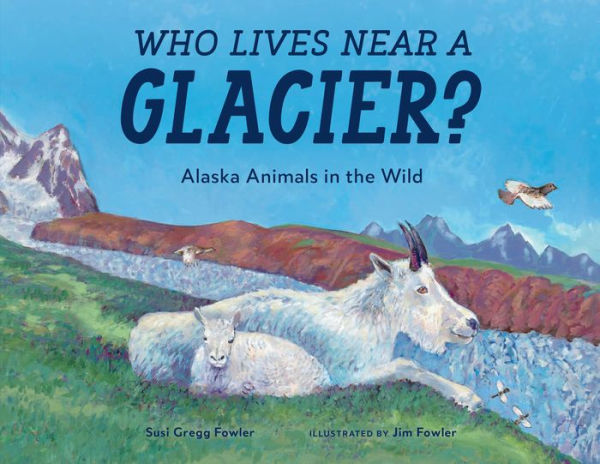Read an Excerpt
WHO LIVES NEAR THE GLACIER?
Not much makes its home on glaciers, I know,
but near them you find more than just ice and snow.
What you see varies with each glacier you visit,
but it all can be thrilling,
surprising, exquisite. Creatures and features to observe and to treasure. The joy of surprise,
a shiver of pleasure.
A prickly porcupine lumping along.
A beaver sliding into a pond.
A seal on an iceberg.
A puffin in flight.
The loon’s haunting cry enchanting the night.
A goat on a rock.
A moose on the shore.
A dragonfly, squirrel,
a salmon, and more.
From forest to stream,
from the air to the ground—
who lives near a glacier?
Just look around!
Alaska has more glaciers than any other state. Scientists estimate the total area of glaciers in Alaska to be 34,000 square miles. That’s a lot of ice!
. . .
HUMPBACK WHALES
It bursts from the water,
lifts into the mists.
Unbelievable that such a creature exists.
Forty tons of whale rising into the space between water and sky—
a moment of grace.
When the gasps, the whoops,
and applause start to lift,
you’re left with the sense you’ve been given a gift.
A humpback whale breaching is hard to describe,
but the memory lingers.
You hold it inside.
And when you remember,
your smile is wide.
Humpback whales are baleen whales. Baleen is a flexible material that hangs in strips from their upper jaws. The whales gulp water, which the baleen filters out, trapping tiny fish and krill behind.
. . .
HOW ARE GLACIERS FORMED?
Glaciers begin to form when snow falls year after year and doesn’t melt away during the summer months. As the buildup of snow gets thicker and heavier, the weight of the top layers presses down on the snow below, compacting it into dense ice. This takes years, but over time the ice becomes so heavy it begins to gradually move down toward sea level, pulled by its own weight, and becomes a glacier. As a result of this slow, flowing motion, glaciers are often called “rivers of ice.”
Ice fields are vast interconnected glaciers, usually across a mountain range, their paths strongly influenced by the underlying landscape.
Valley glaciers are glaciers that spill down mountain valleys. Nabesna Glacier in Wrangell – St. Elias National Park and Preserve, near Copper Center, is the world’s longest interior valley glacier. Matanuska Glacier, another valley glacier, is the largest glacier accessible by car in the United States. It is about 100 miles northeast of Anchorage.
When valley glaciers reach the sea, they are known as tidewater glaciers. Hubbard Glacier, near Yakutat, is the longest tidewater glacier in North America. Some glaciers are tidewater glaciers at high tide but otherwise don’t reach the water. Lituya and Riggs Glaciers in Glacier Bay National Park and Preserve are among those.
Piedmont glaciers occur when valley glaciers spill out into plains and spread out—like a large, icy fan. Malaspina Glacier, located primarily within Wrangell–St. Elias National Park and Preserve, is the largest piedmont glacier in the world. It is fed by ice streams from the St. Elias Range, with Seward Glacier being the principal feeder.
Hanging glaciers appear to be clinging to a mountain. They either originate high on the wall of a glacier valley—but do not descend far enough to connect to the surface of the main glacier—or they become disconnected when left behind as a major valley glacier system retreats and thins. Middle and Explorer Glaciers in the Chugach National Forest, south of Anchorage, are hanging glaciers.
All glaciers are continuously flowing downhill under the force of gravity. When more snow and ice build up on the glacier than melts away, glaciers extend farther down the valley and are described as advancing. A few Alaska glaciers are advancing, including Johns Hopkins and Hubbard Glaciers. However, about 95 percent of Alaska’s glaciers are retreating, meaning that there isn’t enough snow and ice building up to offset the snow and ice being lost to melting and evaporation. These retreating glaciers are getting shorter, ending higher and higher up their valleys, even though their ice is still flowing down. Students, scientists, and leaders around the world are paying attention to the effects of climate change, and glacier study is an important part of that effort.



